Dissolved air flotation pretreatment ensures the quantity and quality of freshwater production during red tides.
10/09/2014
During the last 20 years, the demand for freshwater in the Middle East and North Africa has increased significantly—particularly because this is one of the world’s most arid regions. Larger seawater reverse osmosis (RO) desalination plants have been built to meet the demand. Most of these large facilities have opted for open seawater intakes. Beach-well and infiltration galleries, traditional for smaller systems, have become impractical for the large flows. With proper intake and filtration design, these open intake systems have reliably produced low-salinity water throughout the world.
Harmful Algal Blooms
Traditional open intake RO systems do suffer from one flaw: They are susceptible to harmful algal blooms (HABs). Severe HABs can exceed millions of cell counts per liter and can severely limit plant capacity through rapid filter fouling—or stop production altogether. Near constant filter backwashing prevents the fouling, but leads to poor-quality water being sent to the RO system.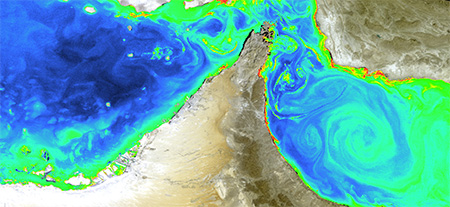 This satellite image shows chlorophyll in the Strait of Hormuz, with green representing moderate levels of concentration and yellow and red representing high levels. High levels of chlorophyll are used to measure algal activity. (Courtesy of TechWorks Marine Ltd.)
This satellite image shows chlorophyll in the Strait of Hormuz, with green representing moderate levels of concentration and yellow and red representing high levels. High levels of chlorophyll are used to measure algal activity. (Courtesy of TechWorks Marine Ltd.)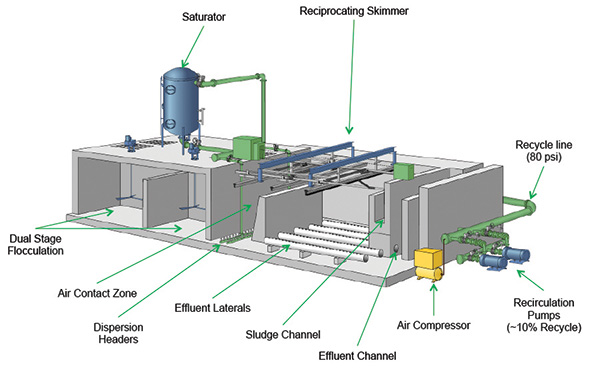 Detailed model of typical dissolved air flotation (DAF) systems (Article images and graphics courtesy of Leopold, a Xylem brand)
Detailed model of typical dissolved air flotation (DAF) systems (Article images and graphics courtesy of Leopold, a Xylem brand)Dissolved Air Flotation
Dissolved air flotation (DAF) pretreatment for open intake facilities can combat HABs. DAF clarifiers have been applied to algae-laden fresh water reservoirs and water treatment systems since the mid-1960s. During the DAF process, millions of micro-bubbles float the algae from the water. The system flocculates the algae into a small micro-floc adding a ferric-based coagulant, such as ferric chloride or ferric sulfate. These small micro-flocs are then mixed with millions of micro-air bubbles.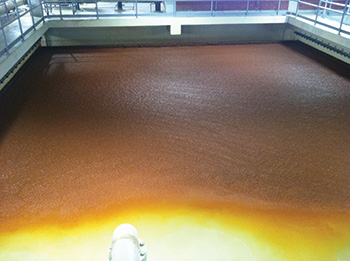 A thick blanket of algae during a bloom floats on top of a DAF basin.
A thick blanket of algae during a bloom floats on top of a DAF basin.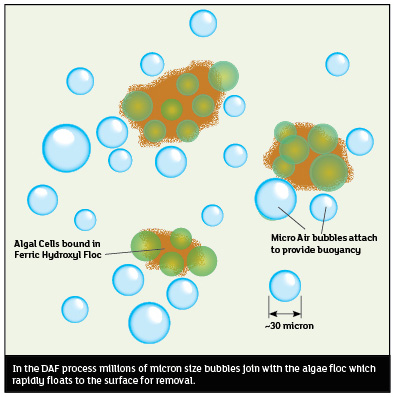 During the DAF process, millions of micron-sized bubbles join with the algal floc rapidly floating to the surface for removal.
During the DAF process, millions of micron-sized bubbles join with the algal floc rapidly floating to the surface for removal.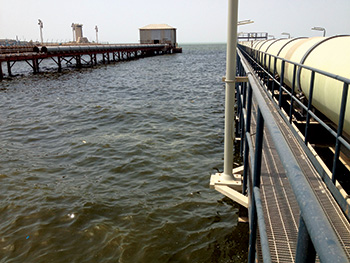 A bloom has turned the water at a desalination plant intake a dark greenish-brown hue.
A bloom has turned the water at a desalination plant intake a dark greenish-brown hue.Case Study: Kuwait
Many Gulf countries have mandated DAF pretreatment for all new seawater reverse osmosis projects that use open intake systems. However, seawater DAF applications are still in their infancy, dating back no more than 10 years. Of the few plants operating DAF for pretreatment in the Gulf, only one has borne the impact of an HAB: the Shuwaikh Seawater Reverse Osmosis Desalination Plant in Kuwait. The Shuwaikh facility incorporates a DAF system and a pressurized inside-out ultrafiltration (UF) for pretreatment. The pretreatment capacity is 350 million liters per day (MLD) with an RO output of 94.7 MLD. The plant is located next to the Port of Shuwaikh, which accommodates the majority of the country’s shipping.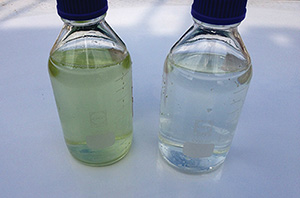 Samples of raw seawater and DAF effluent are compared side by side. The seawater has been supplemented with 100 million cells/L of algae.
Samples of raw seawater and DAF effluent are compared side by side. The seawater has been supplemented with 100 million cells/L of algae. 
